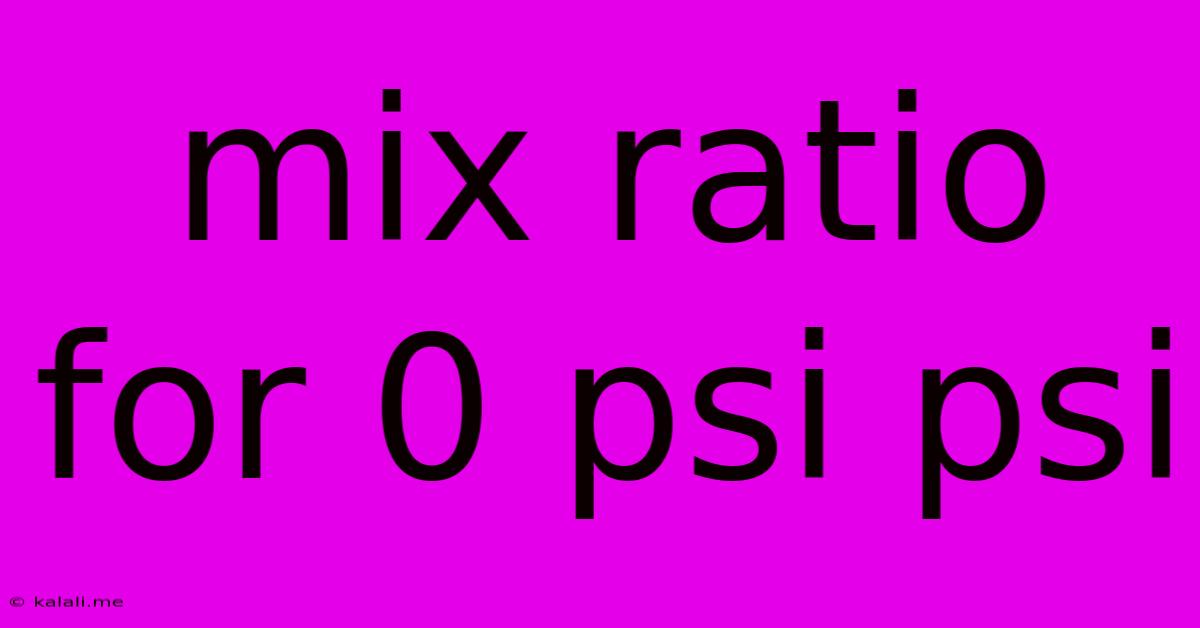Mix Ratio For 0 Psi Psi
Kalali
Jun 03, 2025 · 3 min read

Table of Contents
Understanding Mix Ratios for 0 PSI (Zero PSI) Applications
This article explores the crucial aspect of mix ratios when working with materials designed for zero-psi (0 psi) applications. Understanding the correct mix ratio is paramount for achieving the desired performance, ensuring proper curing, and preventing project failure. We'll delve into the factors influencing mix ratios, common applications, and troubleshooting potential issues. This guide provides a practical understanding for various professionals, from DIY enthusiasts to experienced contractors.
What is 0 PSI?
0 PSI, or zero pounds per square inch, refers to applications where the cured material isn't subjected to significant pressure. This contrasts with high-pressure applications like hydraulic systems. Many adhesives, sealants, and fillers fall under this category, requiring precise mixing for optimal performance. The absence of external pressure necessitates a strong, self-supporting bond.
Factors Affecting Mix Ratio in 0 PSI Applications
Several factors influence the ideal mix ratio for 0 PSI applications:
-
Material Type: Different materials, such as epoxy resins, polyurethane sealants, or acrylic adhesives, have unique chemical compositions and curing processes. Their respective manufacturers specify precise mix ratios for optimal results. Deviation from these recommendations can severely compromise the final product's strength, durability, and overall performance.
-
Application Method: The chosen application method (e.g., brush, trowel, caulking gun) can slightly influence the desired consistency. A thicker mix might be preferable for troweling, while a thinner consistency suits brush application. However, the mix ratio itself remains constant; only the overall volume is adjusted.
-
Ambient Conditions: Temperature and humidity affect curing times and material viscosity. Higher temperatures might accelerate curing, while lower temperatures can slow it down. Humidity can influence the final cure and adhesion properties. Always refer to the manufacturer's instructions for recommended temperature and humidity ranges.
-
Substrate: The surfaces being bonded or sealed also play a role. Porous substrates might absorb more of the mixture, potentially altering the final consistency. Proper surface preparation, such as cleaning and priming, is essential for achieving optimal adhesion regardless of the mix ratio.
Common 0 PSI Applications and Material Considerations
0 PSI applications are widespread in various industries and DIY projects. Examples include:
-
Gap Filling: Sealants and fillers are used to fill gaps and cracks in various surfaces, such as concrete, wood, or metal.
-
Adhesives: Bonding materials together, from small components to larger structures, where pressure isn't applied after the bond is formed.
-
Protective Coatings: Applying coatings for protection against moisture, corrosion, or abrasion.
-
Model Making and Hobby Crafts: Precise mixing is critical for achieving desired consistency and strength in intricate projects.
Troubleshooting Common Issues
Problems arising from incorrect mix ratios typically manifest as:
-
Weak Bonds: Insufficient curing or improper mixing results in weak joints that easily break.
-
Poor Adhesion: An incorrect ratio might lead to inadequate adhesion to the substrates.
-
Uneven Curing: Inconsistencies in the mix can lead to uneven curing, resulting in areas of weakness.
-
Shrinkage: Excessive shrinkage can create voids or gaps, compromising the structural integrity of the bond.
Always Consult Manufacturer Instructions
The most critical step in ensuring successful 0 PSI applications is meticulously following the manufacturer's instructions. These instructions provide specific mix ratios, application methods, and curing conditions tailored to the particular material. Failing to adhere to these recommendations can result in substandard results and project failure.
By carefully following these guidelines and paying close attention to detail, you can achieve optimal results in all your 0 PSI applications. Remember, precision is key when working with materials designed for such applications.
Latest Posts
Latest Posts
-
How Come Ashs Pikachu Forget Thunder
Jun 04, 2025
-
Can I Change My House In Hogwarts Legacy
Jun 04, 2025
-
Baptism Of The Holy Spirit And Fire
Jun 04, 2025
-
How To Remove Rust From Grill
Jun 04, 2025
-
What Does Max Health Do In Diep Io
Jun 04, 2025
Related Post
Thank you for visiting our website which covers about Mix Ratio For 0 Psi Psi . We hope the information provided has been useful to you. Feel free to contact us if you have any questions or need further assistance. See you next time and don't miss to bookmark.